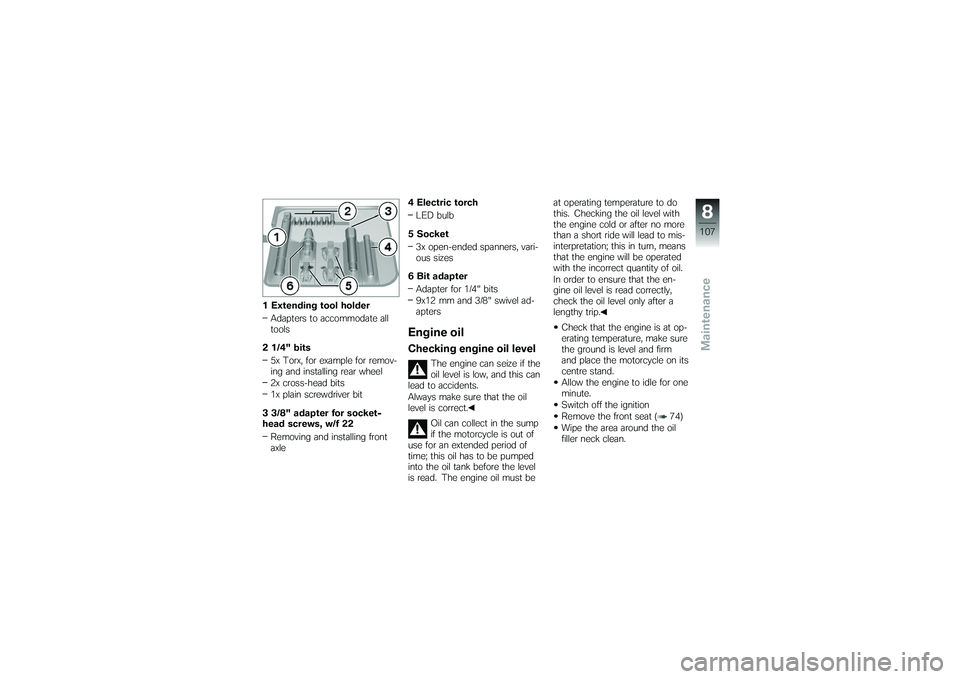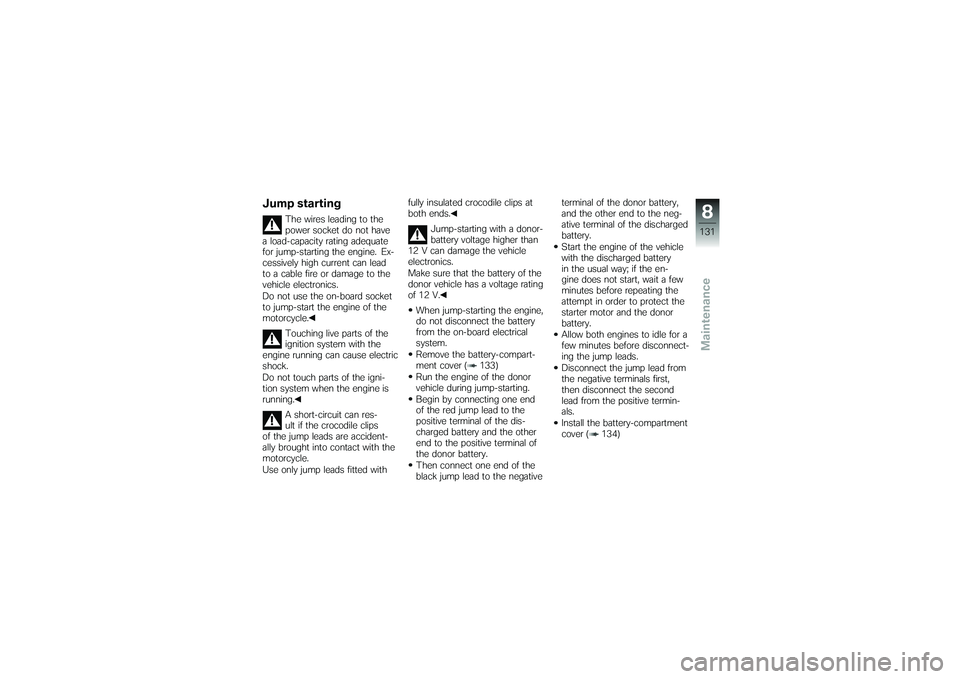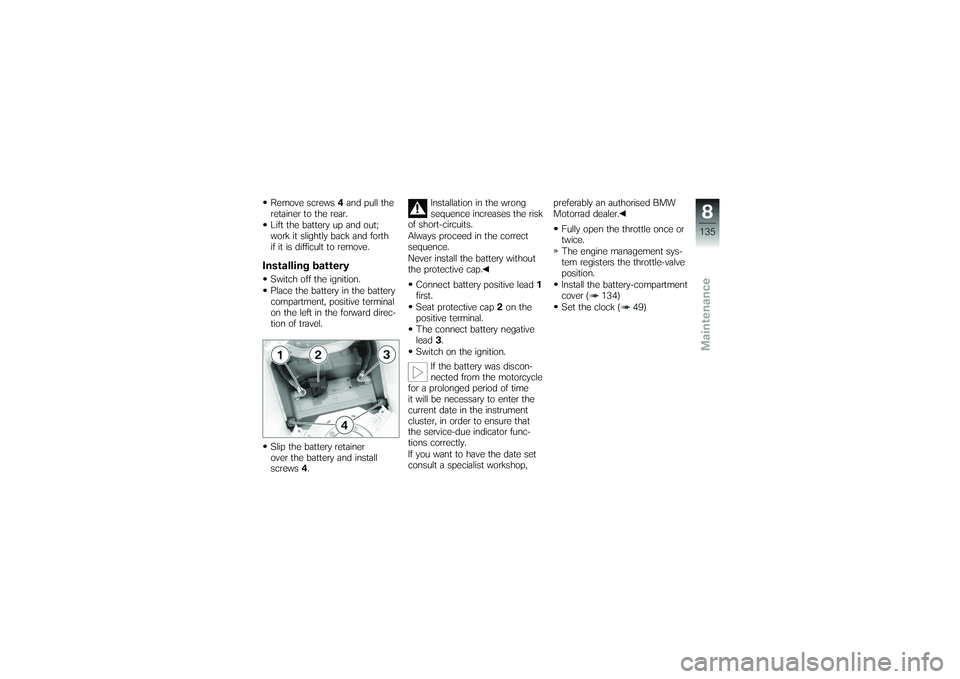Page 97 of 173
Tyre-pressure rangesThe RDC control unit differenti-
ates between three air-pressure
ranges, all of which are paramet-
erised for the motorcycle:Air pressure within permitted
tolerance.
Air pressure close to limit of
permitted tolerance.
Air pressure outside permitted
tolerance.
695zEngineering details
Page 98 of 173
Page 107 of 173
Maintenance
Maintenance
General instructions ................ 106
Toolkit . . . .......................... 106
Engine oil .......................... 107
Brake system, general . . . .......... 109
Brake pads . . . ..................... 109
Brake fluid ......................... 111
Clutch . . . .......................... 113
Tyres .............................. 113
Rims ............................... 114
Wheels . . .......................... 114
Front-wheel stand . . ............... 121
Bulbs .............................. 123
Jump starting . ..................... 131
Battery . . . .......................... 132
8105zMaintenance
Page 109 of 173

1 Extending tool holderAdapters to accommodate all
tools
2 1/4" bits 5x Torx, for example for remov-
ing and installing rear wheel
2x cross-head bits
1x plain screwdriver bit
3 3/8" adapter for socket-
head screws, w/f 22 Removing and installing front
axle 4 Electric torch
LED bulb
5 Socket 3x open-ended spanners, vari-
ous sizes
6 Bit adapter Adapter for 1/4" bits
9x12 mm and 3/8" swivel ad-
apters
Engine oilChecking engine oil level
The engine can seize if the
oil level is low, and this can
lead to accidents.
Always make sure that the oil
level is correct.
Oil can collect in the sump
if the motorcycle is out of
use for an extended period of
time; this oil has to be pumped
into the oil tank before the level
is read. The engine oil must be at operating temperature to do
this. Checking the oil level with
the engine cold or after no more
than a short ride will lead to mis-
interpretation; this in turn, means
that the engine will be operated
with the incorrect quantity of oil.
In order to ensure that the en-
gine oil level is read correctly,
check the oil level only after a
lengthy trip.
Check that the engine is at op-
erating temperature, make sure
the ground is level and firm
and place the motorcycle on its
centre stand.
Allow the engine to idle for one
minute.
Switch off the ignition
Remove the front seat ( 74)
Wipe the area around the oil
filler neck clean.
8107zMaintenance
Page 110 of 173
Remove oil filler cap1by turn-
ing it counter-clockwise.
Use a dry cloth to wipe oil dip-
stick 2clean Seat the oil dipstick on the
oil filler neck, but do not en-
gage the threads. Make sure
that the dipstick is seated in
guide
3.
Remove the oil dipstick and
check the oil level. Engine oil, specified level
Between MIN and MAX
marks (Seat the oil dipstick
on the oil filler neck, but do
not engage the threads.)
If the oil level is below the MIN
mark: Top up the engine oil.
If the oil level is above the MAX
mark: Have the oil level corrected by
a specialist workshop, prefer-
8108zMaintenance
Page 111 of 173

ably an authorised BMW Mo-
torrad dealer.
Install the oil dipstick.
Install the front seat ( 75)Topping up engine oilPour engine oil in through filler
neck1until it reaches the spe-
cified level.
Check the engine oil level
( 107)
Brake system, generalReliabilityA fully functional brake system is
a basic requirement for the road
safety of your motorcycle.
Do not ride the motorcycle if you
have any doubts about the de-
pendability of the brake system.
Under these circumstances have
the brake system checked by a
specialist workshop, preferably
an authorised BMW Motorrad
dealer.
Incorrect working practices
endanger the reliability of
the brakes.
Have all work on the brake sys-
tem performed by a specialist
workshop, preferably an author-
ised BMW Motorrad dealer.Checking operation of
brakesPull the handbrake lever. The pressure point must be
clearly perceptible.
Press the footbrake lever.
The pressure point must be
clearly perceptible.
Brake padsChecking front brake pad
thickness
Brake pads worn past
the minimum permissible
brake-pad thickness can cause
a reduction in braking efficiency
and under certain circumstances
they can cause damage to the
brake system.
In order to ensure the dependab-
ility of the brake system, do not
permit the brake pads to wear
past the minimum permissible
brake-pad thickness.
Make sure the ground is level
and firm and place the motor-
cycle on its stand.
8109zMaintenance
Page 133 of 173

Jump starting
The wires leading to the
power socket do not have
a load-capacity rating adequate
for jump-starting the engine. Ex-
cessively high current can lead
to a cable fire or damage to the
vehicle electronics.
Do not use the on-board socket
to jump-start the engine of the
motorcycle.
Touching live parts of the
ignition system with the
engine running can cause electric
shock.
Do not touch parts of the igni-
tion system when the engine is
running.
A short-circuit can res-
ult if the crocodile clips
of the jump leads are accident-
ally brought into contact with the
motorcycle.
Use only jump leads fitted with fully insulated crocodile clips at
both ends.
Jump-starting with a donor-
battery voltage higher than
12 V can damage the vehicle
electronics.
Make sure that the battery of the
donor vehicle has a voltage rating
of 12 V.
When jump-starting the engine,
do not disconnect the battery
from the on-board electrical
system.
Remove the battery-compart-
ment cover ( 133)
Run the engine of the donor
vehicle during jump-starting.
Begin by connecting one end
of the red jump lead to the
positive terminal of the dis-
charged battery and the other
end to the positive terminal of
the donor battery.
Then connect one end of the
black jump lead to the negative terminal of the donor battery,
and the other end to the neg-
ative terminal of the discharged
battery.
Start the engine of the vehicle
with the discharged battery
in the usual way; if the en-
gine does not start, wait a few
minutes before repeating the
attempt in order to protect the
starter motor and the donor
battery.
Allow both engines to idle for a
few minutes before disconnect-
ing the jump leads.
Disconnect the jump lead from
the negative terminals first,
then disconnect the second
lead from the positive termin-
als.
Install the battery-compartment
cover ( 134)
8131zMaintenance
Page 137 of 173

Remove screws4and pull the
retainer to the rear.
Lift the battery up and out;
work it slightly back and forth
if it is difficult to remove.Installing batterySwitch off the ignition.
Place the battery in the battery
compartment, positive terminal
on the left in the forward direc-
tion of travel.
Slip the battery retainer
over the battery and install
screws 4. Installation in the wrong
sequence increases the risk
of short-circuits.
Always proceed in the correct
sequence.
Never install the battery without
the protective cap.
Connect battery positive lead 1
first.
Seat protective cap 2on the
positive terminal.
The connect battery negative
lead 3.
Switch on the ignition.
If the battery was discon-
nected from the motorcycle
for a prolonged period of time
it will be necessary to enter the
current date in the instrument
cluster, in order to ensure that
the service-due indicator func-
tions correctly.
If you want to have the date set
consult a specialist workshop, preferably an authorised BMW
Motorrad dealer.
Fully open the throttle once or
twice.
The engine management sys-
tem registers the throttle-valve
position.
Install the battery-compartment
cover ( 134)
Set the clock ( 49)
8135zMaintenance